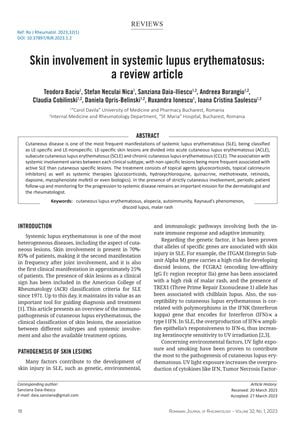Skin Involvement in Systemic Lupus Erythematosus: A Review Article
March 2023
in “
Revista română de reumatologie
”

TLDR Skin problems are common in lupus, often appearing first, with various types and treatments, and careful monitoring is important for diagnosis and management.
Skin involvement is prevalent in systemic lupus erythematosus (SLE), affecting 70%-85% of patients, with skin lesions being the initial sign in about 25% of cases. These lesions are classified as LE-specific (acute, subacute, and chronic) or LE-nonspecific, with specific lesions like acute cutaneous lupus erythematosus (ACLE) being highly associated with SLE. The pathogenesis involves genetic, environmental, and immunologic factors, and treatment ranges from topical agents to systemic therapies. The review underscores the need for careful monitoring of cutaneous symptoms for potential progression to systemic disease and highlights the importance of distinguishing between different types of alopecia in SLE. The 2019 ACR/EULAR criteria for SLE diagnosis now require antinuclear antibodies (ANA) and prioritize the highest-scoring mucocutaneous item to prevent misclassification. Non-specific skin lesions often indicate active systemic disease, and the presence of certain autoantibodies correlates with specific CLE subtypes. Diagnosis is mainly clinical but may be supported by biopsy and immunofluorescence. The CLASI index is used to evaluate skin disease severity, and antimalarials are the first-line systemic treatment. The article calls for collaboration between rheumatologists and dermatologists and further research into molecular markers to predict the progression from cutaneous to systemic disease.






